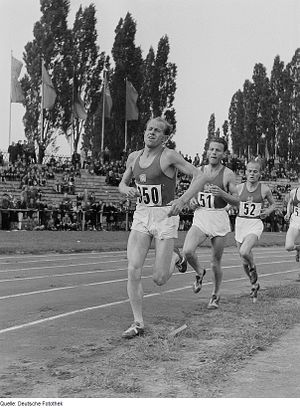Medium Intensity High Volume Intervals
While most interval training is done at high intensity, it is possible to run them at a lower intensity, which allows for correspondingly higher volumes.
1 Emil Zatopek
This approach was used by Emil Zatopek was a runner who set world records and won Olympic Gold medals. Emil is reported to have run up to 100x (400m + 200m recovery), with the 400m a few seconds slower than his 10K pace. That works out as a 37-mile workout, with 25 miles at close to 10K pace. While this level of workout is beyond most recreational runners, doing a larger volume of medium intensity intervals should be considered by experienced athletes.
2 What Pace?
Emil did his intervals slightly slower than 10K pace. For most runners, using the Jack Daniels Running Formula Tempo pace is a good starting point. You can calculate this with the VDOT Calculator.
3 How many?
Emil was an Olympic champion, and most of us have neither the time nor the ability to handle this level of training. As with any speed work, I believe it is important to ramp up the quantity and intensity over time to prevent injury. I would suggest starting with at your tempo pace VDOT Calculator or slower and do 12 repeats. You can then build up the number of intervals over the weeks. This could become the bulk of a midweek training session, or if you are dedicated enough, part of your long run.
4 Possible Benefits
There are three possible benefits from this workout.
- Running at a faster pace has different biomechanics, such as greater activation of the calf muscle and hamstrings. This type of workout allows for much greater time at the faster pace, increasing the training stress of the higher speed muscle activation.
- Because Glycogen depletion increases disproportionately with intensity, this workout will deplete glycogen more rapidly than steady state running.
- Running at a faster pace typically involves greater muscle extension, which will change the eccentric loading, possibly improving DOMS resistance.
